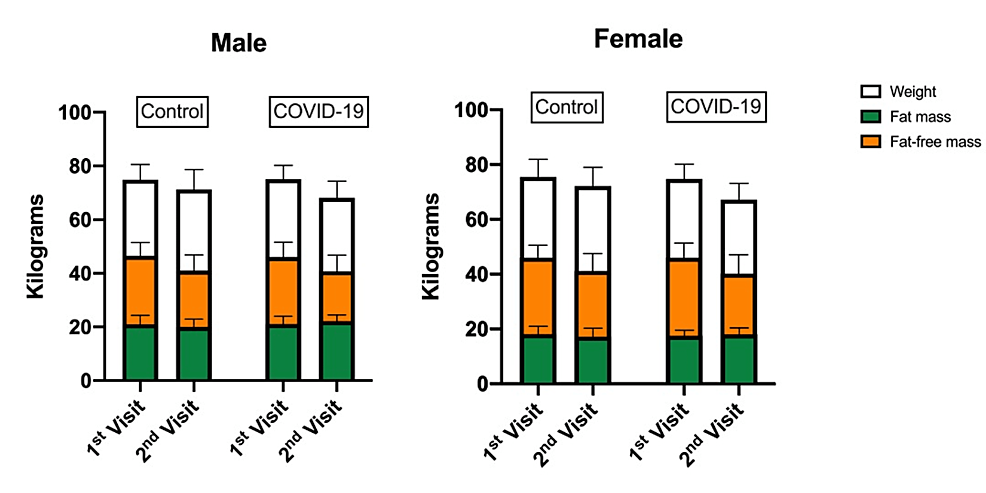In a recent study published in the journal Cureus, researchers explored the relationship between severe acute respiratory syndrome coronavirus 2 (SARS-CoV-2) infection and levels of serum insulin, body fat distribution, and insulin resistance (IR) estimated by homeostasis model assessment (HOMA).
 Study: COVID-19 Induces Body Composition and Metabolic Alterations. Image Credit: New Africa / Shutterstock
Study: COVID-19 Induces Body Composition and Metabolic Alterations. Image Credit: New Africa / Shutterstock
Background
SARS-CoV-2 induces severe cell damage and metabolic dysregulation through the hyperinflammatory immune response and cytokine release. However, the precise pathophysiology governing these effects remains unknown. Also, it is yet not completely understood how coronavirus disease 2019 (COVID-19) affects adipose tissue function and body fat distribution.
About the study
In the present study, researchers randomly selected individuals referred to a university-affiliated nutrition counseling clinic in Tehran, Iran, between July and September 2021. They arranged a balanced (or weight control) diet for all the recruited participants for a month. All study participants completed a food frequency questionnaire (FFQ) with 168 food items with additional information on portion sizes for standard food sizes.
The researchers first collected data on the frequency and the portion size of specific foods consumed by the participants the previous day, month, and year. Next, using a home scale manual, they converted the consumed food quantities into grams for each day. Finally, they computed, for each participant, the total calorie, protein, fat, and carbohydrate consumption for each day. In addition, they collected data on each person’s activity level, height, weight, and body mass index (BMI).
Furthermore, the researchers evaluated their metabolic and biochemical parameters following 12-hour fasting, e.g., insulin concentration. They also measured fat mass (FM) and fat-free mass (FFM), indicating one’s body mass composition, using the dual-energy X-ray absorptiometry (DXA) technique.
The team evaluated the participants on all these parameters in a follow-up session scheduled one month after their first visit. All the participants with mild to moderate COVID-19, as assessed by a positive reverse transcription-polymerase chain reaction (RT-PCR) test, constituted the case group of the study. The remaining healthy cohort formed the control group.
Study findings
Of the 441 patients, 224 were men, and 217 were women, with an average age of 38.82±4.63 years. Expectedly, the total fat (TF) percentage decreased in participants with no COVID-19 (control group) due to the weight-control diet and drop-in energy consumption; this decrease was apparent in 2.5% of females and 1.8% of males. On the contrary, despite losing weight and consuming fewer calories, SARS-CoV-2-infected participants showed over a 2% increase in TF post-infection. This increase was comparable in males and females, close to 2% in both genders.
The average difference in these TF changes between the two groups was significant. The researchers also noted that changes in TF% correlated with differences in metabolic parameters, such as insulin, IR, and glucose. Expectedly, the case group had elevated fasting blood glucose, insulin, and IR, with marked differences in both genders.

The mean of weight, total fat, and fat-free mass in kilograms on the first and second visit in COVID-19 (case) group and control group COVID-19: coronavirus disease 2019
Several previous studies have documented muscle atrophy in SARS-CoV-2-infected individuals, which occurs swiftly, likely within two days of inactivity. In the present study, the researchers noted a reduction of ~6% muscle mass after 10 days of physical inactivity in the case group, which extended to ~10% within 30 days.
Accordingly, both groups experienced a marked reduction in FFM (in the legs, trunk, and arms) on their second visit compared to their first visit. Within almost 30 days, the decrease in lean mass of the legs, trunk, and arms of male participants was 11.4%, 9.6%, and 19.4%, respectively. These reductions were slightly higher for females, with lean mass reductions of arms, legs, and trunks of 21%, 7.9%, and 12.6%, respectively. Reduced muscle protein synthesis likely caused muscle loss post-COVID. Fiber denervation and injury to neuromuscular junctions also contributed to the observed muscle loss.
The case group also showed over a 2% increase in fat deposition, while the control group showed reduced fat deposition in both genders.
Conclusions
According to the authors, the study is unique because no study has ever evaluated the body composition before and after COVID-19 of infected individuals. It also assessed their weight, energy consumption, physical activity, BMI, fasting blood glucose, insulin, and IR.
The study uncovered that despite following a weight-control diet and consuming fewer calories, the TF% of COVID-19 patients surged over 2% after infection. They also had elevated fasting blood glucose, insulin, and IR compared to uninfected controls.
Future studies should investigate the possible mechanism governing changes in TF% and FFM in COVID-19 subjects. Nevertheless, the study findings could inform customized nutrition therapy to improve COVID-19 outcomes.
Journal reference:
- Yazdanpanah M, Mardani M, Osati S, et al., COVID-19 Induces Body Composition and Metabolic Alterations. Cureus 15(1): e34196 (2023). DOI:10.7759/cureus.34196, https://www.cureus.com/articles/130936-covid-19-induces-body-composition-and-metabolic-alterations#!/
 By
By